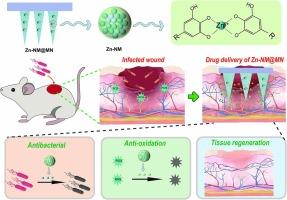基于金属酚类纳米酶的微针贴片具有抗菌和抗氧化作用,可促进感染伤口愈合
IF 5.8
2区 化学
Q1 POLYMER SCIENCE
引用次数: 0
摘要
由于细菌薄膜、活性氧(ROS)过度积累、炎症以及药物渗透性差的传统疗法,慢性细菌感染伤口愈合日益严重,死亡率和致残率居高不下。Herin是一种具有优异抗菌和抗氧化能力的功能性锌-胆酸纳米酶(Zn-NM),它与明胶基微针贴片(Zn-NM@MN)相结合,实现了药物在感染伤口部位的透皮和持续释放。Zn-NM 具有浓度依赖性抗菌能力,250 μg/mL 的 Zn-NM 同时具有优异的抗菌性(对大肠杆菌的抗菌率为 89.36 ± 0.95 %,对金黄色葡萄球菌的抗菌率为 92.44 ± 11.03 %,对耐甲氧西林金黄色葡萄球菌的抗菌率为 95.03 ± 1.06 %)、抗氧化性和可忽略的细胞毒性。之后,Zn-NM@MN 可透皮表皮或生物膜,使 Zn-NM 的释放持续 3 小时(释放 80% 的药物)。对大鼠受感染的全厚皮肤伤口进行的系统组织再生评估显示,伤口愈合率有所提高。Zn-NM@MN 能有效杀灭细菌(约 85%)、缓解氧化应激、减轻细菌引起的炎症反应并促进血管再生。这种协同治疗策略将为治疗复杂的感染伤口铺平道路。本文章由计算机程序翻译,如有差异,请以英文原文为准。

Metal–phenolic nanozyme based microneedle patch with antibacterial and antioxidant for infected wound healing
Chronic bacterial-infected wound healing is becoming increasingly severe, with high rates of mortality and disability, owing to bacterial film, excessive accumulation of reactive oxygen species (ROS), inflammatory, and traditional therapeutics with poor drug permeability. Herin, a functional Zn-gallic acid nanozyme (Zn-NM) with excellent antibacterial and antioxidant capacity was incorporated with a gelatin-based microneedle patch (Zn-NM@MN) to achieve transdermal and sustained release of the drug at the infected wound site. The Zn-NM displayed the concentration-dependent antibacterial capacity, and 250 μg/mL of Zn-NM simultaneously possessed excellent antibacterial (89.36 ± 0.95 % for Escherichia coli, 92.44 ± 11.03 % for Staphylococcus aureus, and 95.03 ± 1.06 % for Methicillin-resistant Staphylococcus aureus), antioxidant properties and negligible cytotoxicity. After that, Zn-NM@MN could transdermal the epidermis or biofilm to sustain the release of Zn-NM for 3 h (release of 80 % drug). Systematic tissue regeneration assessment on rats’ infected full-thickness skin wounds demonstrated an enhanced wound healing rate. Zn-NM@MN could efficiently kill the bacteria (about 85 %), alleviate oxidant stress, reduce bacterial-induced inflammation, and promote vascular regeneration. This synergetic therapy strategy will pave the way for treating complicated infection wounds.
求助全文
通过发布文献求助,成功后即可免费获取论文全文。
去求助
来源期刊

European Polymer Journal
化学-高分子科学
CiteScore
9.90
自引率
10.00%
发文量
691
审稿时长
23 days
期刊介绍:
European Polymer Journal is dedicated to publishing work on fundamental and applied polymer chemistry and macromolecular materials. The journal covers all aspects of polymer synthesis, including polymerization mechanisms and chemical functional transformations, with a focus on novel polymers and the relationships between molecular structure and polymer properties. In addition, we welcome submissions on bio-based or renewable polymers, stimuli-responsive systems and polymer bio-hybrids. European Polymer Journal also publishes research on the biomedical application of polymers, including drug delivery and regenerative medicine. The main scope is covered but not limited to the following core research areas:
Polymer synthesis and functionalization
• Novel synthetic routes for polymerization, functional modification, controlled/living polymerization and precision polymers.
Stimuli-responsive polymers
• Including shape memory and self-healing polymers.
Supramolecular polymers and self-assembly
• Molecular recognition and higher order polymer structures.
Renewable and sustainable polymers
• Bio-based, biodegradable and anti-microbial polymers and polymeric bio-nanocomposites.
Polymers at interfaces and surfaces
• Chemistry and engineering of surfaces with biological relevance, including patterning, antifouling polymers and polymers for membrane applications.
Biomedical applications and nanomedicine
• Polymers for regenerative medicine, drug delivery molecular release and gene therapy
The scope of European Polymer Journal no longer includes Polymer Physics.
 求助内容:
求助内容: 应助结果提醒方式:
应助结果提醒方式:


